|
From the Master’s correspondence
THE MYSTERY OF PAINTING GENERATED BY COLOUR
Tutto il lungo percorso artistico di Beppe Assenza è stato sempre caratterizzato da un grande anelito: conferire vita al colore.
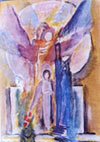 |
| Confirmation * |
What characterized the life-long path followed by Beppe Assenza was the great yearning to breathe life into colour.
Seeing that it is true that colour is the primary expressive means in painting, in the final analysis the entire history of art demonstrates in all epochs, even with stylistic diversity, constant research to obtain from that colour an ever increasing eloquence. Assenza felt in colour property of calling forth particular deep sensations, beyond the ordinary eloquence.
Initially Assenza’s research led him to immerse himself in the experience of expressionism, which at that time had reached its zenith, but he was left deeply disappointed.
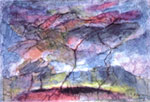 |
| Water Colour, without title * |
The overwhelming chromatic liveliness characterizing that current did not correspond to the intimate, but more vital sensations of colour that grew out of his soul and which he, all the same, was still unable to obtain from his own palette, rich as they were, nor which he could foresee as realizable in the most advanced pictorial techniques of the time.
It was only later on that he got to know about the anthroposophical conception of the universe and, within its realm, the original conception too of Goethe and Rudolph Steiner of the essence of colours and, including their rich, vital and intimate sensations that they, when left to work following their own nature, led to bear on the depths of the soul.
Rudolf Steiner’s thrust for the renewal of pictorial art based on this knowledge was a revelation for Assenza. He felt that by deepening it he would be able to open the way to breathe active life into the colours of his paintings.
He therefore spent many years working on refining his capacity to perceive the eloquence of individual colours, and their behavioural requirements, through the sensibility of the soul.
We can in fact see that the nature of colours themselves and the laws of their dynamics, and so too the possibilities for their multiform manifestations, cannot be reduced to simple rules, as they can be perceived only in the soul.
The expert can only suggest certain indications of a general nature concerning the more common situations to participants, but when developing a chromatic composition according to the anthroposophical conception of painting, the artist must lay his soul open to grasp and so feel in each and every circumstance the need for the movement of the colours, taken both individually and in their correspondence with others.
Clearly this is what Beppe Assenza meant while commenting on the clear cut indication of Rudolf Steiner: “Painting extracting from colour” in his letter of 27 November 1976 to this writer, expressing himself in this manner:
“Aus der Farbe heraus malen (trans.: painting extracting from colour) is a mystery. To touch it one needs an enquiring act in the sphere of conscious creation through seelische Beobachtung (trans.: the observation through the soul).”
We can understand his words as an invitation to contemplate the colour in a deep interior silence so as to hear it alive and present, almost touching it, in our whole being, so as to be able to perceive fully consciously which other colours it calls upon and how it wishes to move in relation to them.
---Piccola.jpg) |
| Water Colour, cm 40 x 35, without title (private collection) * |
Only a chromatic process which one deeply lived into his conscience, until it become part of his own being, may be called a real cognitive act of all the forces involved. Only through a deep experience of such a kind, a real conscious cognitive act can come true.
Certainly this is Assenza’s thought. This was the way Assenza was used to work.
Assenza goes on to carry out the entire procedure, but completely freely, strictly observing the requirements of movement and further combinations, expressed by the situation contemplated with the soul. This can be so because the natural laws of colours do not come forth in a univocal manner, but instead allow for un unlimited possibility for action to be chosen by the operator. Just as an architect who is fully conscious of the laws of physics and chemistry concerning the materials being used feels free to create according to his own fantasy, even while respecting them carefully.
Clearly Assenza’s way of operating is substantially different from the method generally followed by many others who work in colour. They are used to seeking to grasp the colour awoken in their consciousness by an emotion aroused when confronted with an event or a thought-out theme, so as to go on to pose it on canvas and develop it according to their own feelings.
This is a subjective manner for using colour, while Assenza works to an objective procedure.
THE COMPLETION OF A CREATION
What has so far been described is just the first stage of Beppe Assenza’s creative procedure.
In his letter to the writer on 31 August 1976, the Master made further clarifications:
“Summing up of the three stages:
1st. Give life to the material from the elementary state (autonomous pictorial organism);
2nd. Incarnation of the idea;
3rd. Transubstantiation of the material through the form and the idea.”
Just a few words, but full of meaning.
The painter has just the material consisting in various individual colours, alone and independent, in the pure state. With these he proposes to create a “composition” to then finish it in a meaningful pictorial work. Assenza does not use the term “elaborate the material” to describe this process, but goes further to mean “give it life”. This is possible only if one works in the way mentioned above.
This is the anthroposophical project for a painting. It is not just composing the colours together in a pleasant, meaningful and balanced way, but of composing them so that they appear to be living.
The process should lead to the execution of an “autonomous organism” that has its own justification, that is complete and has a full meaning so as to be able to bear its own weight and in which each individual element does not exist in itself, but as a function of the others and so of everything. Nothing it contains should appear useless or extraneous, but instead as indispensable in providing a feeling of togetherness.
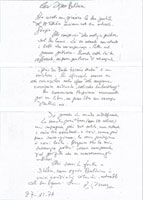 |
| Extracts from letter of November 27, 1976 |
In a letter of 10 October 1973, Assenza specified the simplest, most basic elements of a chromatic organism. He wrote:
“ From a pictorial point of view, when facing a study in colour, one can ask oneself ‘Just how far have purely pictorial elements been realized, colour, movement, form and character?’”
These are the key points of the pictorial procedure. Assenza did not consider them as mere elements in a composition, but as essential components that have their own independent existence and mode of being, which, however, must insert themselves harmoniously among the others.
A colour manifests itself in its multiple aspects, that is in a variety of tones: strong, middle, pale or a nuance, but cannot remain isolated. It feels the need to join in with other colours, but which?
The movements, which develop from the dynamisms of the colours, change continuously to keep up with the metamorphoses coming into play. But they do not follow mechanically the succession of events; they live in the soul as forces that weave and build and must be guided by it.
None of this can be left to the moment’s whim and of taking on anyhow the most varied characteristics. They must form a single discourse. Their developments must be consequential and build a unitary state. This is the form.
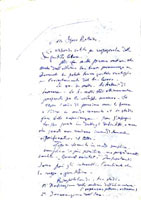 |
| Letter of August 03, 1976, page 1 |
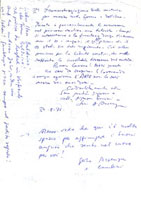 |
| Letter of August 03, 1976, page 2 |
Finally a clearly defined characteristic must emerge from the whole, which divides it off and makes it stand apart from all the others. Each is a world in itself. It will therefore have its very own character.
Now we can understand the warning of the Master we have just quoted. When considering a colour study you have to reflect and ask yourself if you have correctly realized the four fundamental pictorial elements.
We have still not said it all. In his letter dated 3 August 1976, the Master recalled that:
“ The intervals are important and so too the ambiance that sustains and justifies them”. The respect for them and the intelligent use of them forms one of the strong points in Assenza’s painting.
In fact, just as in music, the meaning of a phrase or a composition and the emotion that derives from them are not determined, as is frequently believed, by a succession of sounds, but by the intervals that stand between them, so too in the painting as practised by Assenza.
Colours follow one on another in Goethe’s circle, but while some are juxtaposed, or separated by other colours. Each of these intervals has its own precise resonance, “Klang” as the Master calls it in German. The resonance arouses very clear sensations in the soul. It is a music of colours, which unfolds in its song.
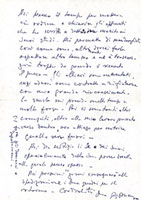 |
| Extract from letter of October 10, 1973, part 2 |
The intervals constitute something of primary importance in Assenza’s painting, providing it with its meaning and life.
But they are not applied casually here and there so just as to arouse emotions. Each one must have its own justification and insert itself harmoniously in the overall picture.
The composition with its colours, gestures and forms can suggest an “idea” for the artist that he will later incorporate in the composition itself. When he used term “incorporate”, Assenza wished to stress that is was not just to “transform” the forms into figures, but to re-elaborate the various parts of the composition (nevertheless without changing their nature) to make them conform to the idea so that they all come together in the creation of an ambience and fully represent it.
The third stage: “Transubstantiation of the material through the form and the idea” is in fact a continuation and a further refining of the previous stage. That is, from now on the idea will suggest any further elaboration of the colours, the strokes and the forms, so that the whole expresses it immediately and clearly.
Each and every element that appears extraneous to the idea will be modified and reduced to take on the function of a support for the idea itself and to highlight the ambiance even more.
Clearly every transformation will nevertheless take place in full respect of the nature and dynamics of the colours, as well as the compositional equilibrium.
So as to be completely clear and understandable, it should be said that the term “transubstantiation”, so dear to Assenza, should be adopted in its real and most limited meaning of the transformation of a substance into another.
For example, if, before this operation, the careful observer who is contemplating the work sees standing out above all, and rightly so, the character of the composition so that he says to himself: here is an experience in blue-red or in orange-violet-green, or something else, now his consciousness will grasp with primary immediacy the idea of the painting. It will no longer appear to him simply as an experience of colour, but will become for him effectively the idea in which that experience has been transformed.
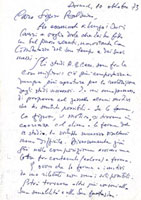 |
| Extract from letter of October 10, 1973, part 1 |
FREE CREATIVITY
For Assenza, the idea can spring forth in the consciousness of the artist usually when the composition has been completed and has taken on a precise character (1st. stage) but can also emerge unexpectedly as an intuition during the work. In such a case, he will already be able to begin to incorporate the idea in the colour composition and set out on the process of transubstantiation. In fact, Assenza continued in his letter of 30 August 1976:
“This is generally the succession in the creative process, but sometimes the times cross over and fantasy directs interest towards the 2nd stage or even the 3rd. before reaching the 1st stage.
This underlines that creative freedom unwillingly obeys the inevitable tyranny of the method.”
Any pictorial procedure, which is not just instinctive, but stands on the solid bases of principles, must necessarily propose a method. Many values have to be considered and kept to if one wishes to create a pictorial work with both content and form. All the same, as the Master observes, creative freedom is part itself of the nature of art and unwillingly accepts the tyranny of method even if it is always inevitable.
With a chronological description of the individual transitions in the method of Assenza, one gains the impression of dealing with a rigid discipline. Instead, as the preceding passage clearly shows, the procedure of Assenza takes place with the greatest freedom, as, in art, what arises spontaneously in the soul thanks to intuition must always be respected. So it may be the case that the various transitions do not always follow the given order but are intercalated following the suggestion of the sensation. Nevertheless, it is vital that, either before or after, the different points in the method, which are essential and unavoidable, find their own space and fulfilment.
To a letter of the writer in which he laid bare his difficulties in the realization of an idea, the Master replied on 6 August 1975 so:
“I can understand your problems with figuration. Leave it for a while – or at least do not force the vision. It should spring up alone, so as to say, from the maturity of the painting.
Do not grow tired of proceeding towards an even clearer formation (every painting should reach its own individual unmistakeable physiognomy), glancing at, perhaps, something that is going on maturing in the fantasy maybe it can be inserted organically, enabling everything.”
Even before in a latter on 10 October 1973, Assenza had clarified:
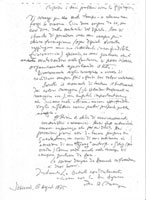 |
| Extract from letter of August 06, 1975 |
“It is not worth stressing that it is not necessary to make every study into a picture. Studies can be developed all the way without figures or motives too. In fact, remaining in the pure study of colour (the simpler it is, the better) can be advisable as a necessary withdrawal to allow further focus in consciousness of the moral experience.”
And further on:
“If the forms, the figures and the motive are coherent with the climate and the forms of the first study, development will be easier to follow. It is otherwise already when a struggle takes place between the content (colour) and the form in the composition.”
This all shows how, even if the finality of a pictorial process developed through anthroposophical intentions gives precedence to the representation of an idea, for Assenza nevertheless the formation of a colour composition, constructed organically and active as the source of profound sensations, was still always of primary importance.
The Steinerian-anthroposophical vision of painting places first the whole task of creating a chromatic composition in which colour acquires life and creative force, so as to reflect the light-colour essence that weaves in the universe.
If this requirement is not met, any attempt to go on to draw from the figurations will merely create a simple illustration of something, a lifeless representation, as it is not born from the living essence of colour. Thus Assenza laid down above all the requirement to deal primarily with the colour composition up to feeling it living in consciousness, experimenting intensely with it. In this way we later manage to know it. The idea can only be released by this conscious experimentation.
It is also vital to stress that while the basic principle of the Goethean pictorial current aims at the birth of the idea extracted from a finished colour composition, due to the freedom of expression and procedure, no preconception excludes the faculty to realize works starting from a predisposed theme, if particular circumstances suggest it.
In this case Assenza takes into consideration the basic colours useful in illustrating it and develops the composition following the description given before, that is, following only the natural requirements of those colours chosen beforehand. On concluding the chromatic component he will seek to identify the gestures and forms best suited for the incorporation and representation of the theme. The project must always be in perfect tuning with the chromatic composition and be able to emerge from it in a natural way. Otherwise it is best to leave it aside and allow the emergence from the composition what is really suggested by the intuition.
SPLENDOUR COLOURS AND IMAGE COLOURS
In a letter dated 6 August 1975, the Master further wrote:
“It may be the time to attempt to handle image colours (splendours transformed into image etc.), a very important chapter that we together have still to deepen. I would like to reflect on how I could propose some exercises to you.”
The master dedicated above all the last years of his life of pictorial activity to the intensification of the experimentation on Steiner’s innovation in the classification of colours in “splendour” and “image”.
Each one expresses something essential. What shines out in interiority creates a corresponding image in it.
For example, the interior perception of red (splendour of life) gives rise to its “shadow” of green, the dead image of life. The latter is in fact the characteristic of living vegetation.
In order to simplify the understanding of the difference between splendour colour and image colour, we can consider, for example, how yellow, considered as the splendour of light and spirit is really perceived within the interiority as light and so too as spirit. On the other hand, white, classified instead as dead image of light and spirit on observation certainly offers the idea, the impression of light and the candour of the spirit, but does not let them be perceived as living in the interiority as is the case with yellow, and so remains just image.
Thus while blue is perceived as the splendour of the soul, its “shadow”, the colour of “peach flower”, that is the colour of incarnation, is the image of the soul which lives in the interiority of the human being.
The image colours, by adopting the correct veiling, can be transformed into image-splendour, others into splendour-image.
The result in every composition is that, if the colours are attributed figurations corresponding to the essentiality of splendour or image, they really become a living expression of what they represent.
When observing a painting by the Master Assenza, just as when observing a true Steinerian painting, we should not jump straight to asking ourselves what it represents, what is the meaning of this or that or something else. We have to leave aside for the time being any consideration on the values of content or form, leaving it free to act in the soul. A picture is not like a book to be read!
We must contemplate it with the mind unhindered by thoughts and so then the colour slowly will come to life in the consciousness, fascinating it and raising it up to the world that the painting wishes to represent. I will learn to know a painting only if first it is left to live in the soul.
This is the painting of Master Beppe Assenza.
He studied Steiner’s indications carefully over a long period, regarding both the indication in conferences and those left in his many notes on the argument. Starting from these bases, he defined a procedure aiming at following the principles and seeking the goals indicated by Steiner for the realization of a painting created by colour. His procedure has taken on form and is now known as “the Beppe Assenza Method”.
|


---Piccola.jpg)





